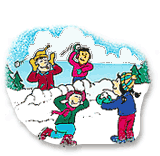
Everyone is susceptible to frostbite and “frostnip,” but children are at greater risk than adults because they lose heat from their skin faster. Making matters worse, children may ignore how cold and uncomfortable they are just to keep having fun.
Identifying Frostbite
Early frostbite is characterized by waxy, white and hard skin that feels numb and has a persistent burning sensation. In more severe cases, frostbitten skin will become blue and mottled or splotchy.
Identifying Frostnip
An earlier form of frostbite called “frostnip” also can be a problem for children. It usually affects the ears, nose, cheeks, fingers and toes. If a child has frostnip, the affected area will be white and numb.
Preventing Frostbite and Frostnip
Frostbite can attack when temperatures are below freezing. Wind and humidity can shorten the time it takes for frostbite to occur. Follow these recommendations to prevent frostbite and frostnip for yourself and your children:
- Do not go outside in very cold weather after a recent bath or shower.
- Wear warm clothing and dress in layers.
- Layer 1 – wear clothes that will keep moisture away from the skin. Thermal underwear, moisture-reducing winter sportswear, cotton socks and mitten and glove liners are good items to use. The first layer, like the other layers, should not be so tight that circulation is impeded. Layer 2 – wear loose clothing that is intended to resist dampness and maintain body temperature. Heavy pants, sweaters and sweatshirts are good items for layer two. Layer 3 – wear tightly woven moisture-resistant outerwear. Moisture-resistant coats and jackets, hats, scarves, gloves and mittens and boots are good third layer items.
- Bring children in at regular intervals and inspect fingers and noses for signs of frostnip and frostbite.
- If you are away from home, take extra clothing along.
- Keep dry. Wet clothes increase chance of heat loss.
Treating Frostbite
Severe frostbite requires immediate medical attention. If you suspect that your child has frostbite, remove cold and wet clothing. Dress the child in clothing that is loose, warm and dry, and take the child to a hospital.
Do Not:
- Do not rub or bump the affected area.
- Do not use direct heat such as a heating pad or hair dryer to warm the affected area.
- Do not pop blisters that appear. Popping blisters on frostbitten skin can cause infection.
If you are not able to get a child with frostbite to a hospital right away, begin first aid:
- Give child something warm to drink, and keep child hydrated.
- Keep child warm with clothes and blankets.
- Soak frostbitten area in warm water (between 101° to 104° F). If you don’t have a thermometer, dip your elbow in the water. If the water is too hot for your elbow, it’s too hot for the child. Maintain temperature of water by adding warm water if necessary.
- Soak affected area until it becomes pink.
- If the child’s face is frostbitten, use a soft washcloth. Soak the wash cloth in warm water and wring out any excess.
- After the affected skin turns pink, dry the skin – gently but thoroughly – and wrap with clean gauze bandages.
- If the toes or fingers are frostbitten, place gauze bandages or cotton balls between toes and fingers to permit these areas to dry. Thoroughly drying affected areas can prevent infection.
- The child may have a burning sensation after warming.
- The affected skin may blister, swell, become painful or turn blue, red or purple.
- Seek medical attention as soon as possible for a thorough exam and additional treatment.
- Avoid further exposure to the cold – especially with the affected areas.
Treating Frostnip
- Get the child indoors.
- Remove wet clothes.
- Submerge affected areas in warm water (between 101º to 104º F). Do not permit the child to control the temperature of the water.
- Keep affected areas in water until they turn red.









